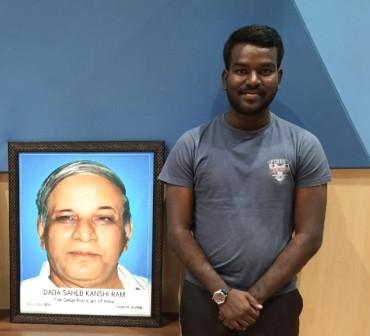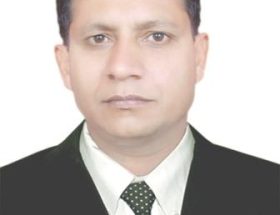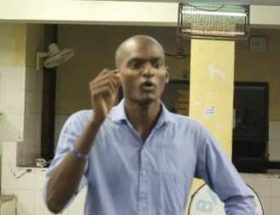Ganesh Kamble
We, a group of twenty-eight students, were placed by our university for a three-month field practice stint in Barmer. It is a prominent district in the Thar desert, which is part of western Rajasthan. It was my third field practice. Field practice is one type of internship. Before going to the field, I was shocked because of the ‘Jalore Incident‘. Jalore is also a district in Rajasthan. In this district, an upper caste school teacher murdered a Dalit boy. The reason was that the Dalit boy touched a water pot that was placed in an upper caste teacher’s office. The cruel and cold-blooded teacher beat him, and once again, an innocent Dalit boy died solely for the reason of impurity, which is associated with the lower caste status codified by Manusmriti and sanctified by the Hindu religion’s Varna System.
In this field, our primary tasks were teaching and research in schools and taking the Teachers Professional Development Course (TPD) at the District Institute of the Azim Premji Foundation. Our instructor and field mentor made us aware that Barmer is also a place where mostly upper caste people follow the caste system. Let me give more clarity about what it means to follow the caste system in the context of Barmer district. First, asking a new person their caste name is a common practice among students and the general public. Even, students are part of the community. Second, asserting the name of a caste loudly and with pride is also a common thing. Finally, treating Dalit and Adivasi students differently based on their caste/tribal identity is a common practice. This is how the place was. And even now, it is a place of discrimination. These are just a few incidents that I experienced during my fieldwork in a semi-urban area. For sure, there are harsher realities in the inner parts of Barmer that I couldn’t see.
When I entered the school after some days, many students frequently asked me about my caste identity. How can I tell them, “Hey! I am Dalit,” as I don’t have any higher status in this caste-based society! During this scenario, many times I turned away and changed the topic of the students’ discussion. At the same time, I observed that many students loudly shared their caste identity with me: “I am Rana Rajput,” “I am Rajput,” “I am Parihar,” “I am Jaat,” and so on. One student came to my desk and shared his caste name in my ear. All these students belong to the upper castes. Even students did not hesitate to reveal their caste in front of the teacher. Teachers, too, took it casually. Let me clarify one more aspect of the caste system here. Dalits and Adivasis are at the bottom of the caste ladder. Those above them in terms of hierarchical social status will remain the upper castes for them, including OBCs.
On one occasion, I opened my laptop to register students’ names for the purpose of a student portfolio. When I asked one of the tribal girls to say her surname loudly, she bowed her neck to the ground. I noticed her; she was silently and continuously staring at the floor. She was hesitant to reveal her surname. Because, her caste name was too attached to her surname. She belonged to the Bhil community. And she was well aware that if she mentioned her surname in class, everyone could learn about her caste status. Her classmates told me her surname. In Maharashtra, I too went through this type of situation. My surname is Kamble, and it is associated with Dalit communities such as Mahar and Mang. When my upper caste friends heard my surname, they would ask, “Hey Ganesh, you are Jai Bhim, right?” I also bowed my neck and looked down at the floor at the time. This feeling is quite annoying to any lower caste person, particularly Dalits and Adivasis. Only a Dalit and a tribal can understand their backwardness. And they understand the atrocities that happen to both of them.
As part of the TPD course, I attended many workshops. Prior to that, during recess, I was observing certain students carrying lunch plates in their bags. One question was consistently coming to mind: why are they carrying plates in their backpacks when they are already heavily burdened with books? I got an answer to that question during the workshop. The workshop was on the theme of ‘Safe School Environment and Inclusive Education’. In many places across the state of Rajasthan, Bhil community students carry lunch plates in their backpacks because if they eat in plates that are provided by the school, the upper castes students boycott eating in those plates. The reason behind this phenomenon is simple: lower-caste students are impure, polluted, and unclean. “We cannot consume food on plates that are used by them (the Dalits and Adivasis), because Dharma will be corrupted and become impure.”
Other than these experiences and observations, I also scrutinized my surroundings. I found open symbolization of caste identities through nameplates of castes on vehicles and hotels, restaurants, and lodges. Usually on vehicles, nameplates looked alike: Chaudhari, Jaat, Rajput, and Brahman, with crown designs that demonstrate a symbol of superiority over the people.
Overall, these incidents reinforce superiority of upper caste communities over Dalits and Adivasis in Indian society. This kind of symbolism through nameplates tends to spread and enforce strict caste-related norms and rules in society. It manifests the casteist mentality of upper caste people. It indignifies Dalit and Adivasi communities, which is against the constitutional morale and ethos of liberty, equality, and fraternity. The outcome of these conditions is the humiliation of Dalits and Adivasis.
The Jalore incident of caste-based discrimination just happened before the 75th Independence Day of the Indian Republic. This is ‘unfreedom’, as conceptualized by Nobel laureate Amartya Sen, that Dalits and Adivasis are continuously facing in school spaces. How can they uplift themselves while living in a narrow-minded and casteist environment that restricts one’s growth and development, despite the fact that the door to education is open? Tell me how we are supposed to celebrate Independence Day. It’s been 75 years since we got our political freedom. Think over!
~~~
Ganesh Kamble, is pursuing the MA in Education program at the School of Education, Azim Premji University, Bangalore. He has a BA in Economics from Fergusson College, Pune.










